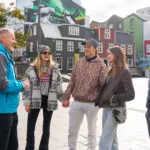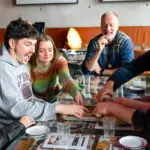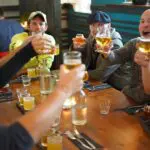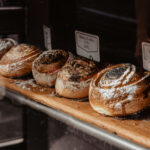The Golden Circle is one of Iceland’s most iconic routes — and for good reason. In just one day (or a relaxed two), you can visit thundering waterfalls, spouting geysers, rift valleys, volcanic craters, and some of the country’s most important historical sites. It’s a perfect mix of dramatic nature and cultural heritage, all within easy reach of Reykjavík. This Golden Circle travel guide will help you uncover both the highlights and the hidden gems.
The classic route includes three main stops: Þingvellir National Park, the Geysir geothermal area, and Gullfoss waterfall. But there’s much more to explore. Along the way, you’ll find small museums, cosy local restaurants, greenhouses serving fresh tomato soup, and geothermal pools tucked into quiet villages.
Whether you’re renting a car for a self-drive tour or joining a guided trip, this Golden Circle travel guide is here to help you get the most out of your journey. Below, you’ll find the top historical sights, lesser-known museums, natural wonders, and food and drink spots worth your time.
Golden Circle at a Glance
🏛️ History of the Golden Circle
🏞️ Museums to Visit along the Golden Circle
📍 Must-Visit Natural Wonders along the Golden Circle
🚘 Tours and Activities on the Golden Circle
🍽️ Best Places to Eat and Drink on the Golden Circle
👻 Folktales & Legends
History of the Golden Circle
What sets this region apart is its deep cultural and political importance. In this Golden Circle Iceland travel guide, we go beyond the scenery. We visit the places where Iceland’s story began — from the world’s oldest parliament to historic churches and early geothermal use. The Golden Circle isn’t just about nature. It’s also a journey through Iceland’s history.
Þingvellir National Park

Þingvellir (or Thingvellir) is a UNESCO World Heritage Site and one of the most important places in Icelandic history. It’s where the Alþingi, Iceland’s national parliament, was first established in 930 CE. Representatives from across the country would travel by horseback to gather at this open-air assembly. Here, they passed laws, settled disputes, and held public ceremonies — including executions.
Þingvellir wasn’t just a political hub. It was also a place for trade, socialising, and storytelling.
Even after the Alþingi moved to Reykjavík in the 1800s, Þingvellir remained a strong national symbol — especially during Iceland’s independence movement. It’s often called the heart of Icelandic identity.
Geologically, the park is just as remarkable. It sits on the Mid-Atlantic Rift, where the North American and Eurasian tectonic plates slowly drift apart. This creates deep cracks and fissures in the land, including Almannagjá, a dramatic canyon you can walk through.
In this Golden Circle Iceland travel guide, Þingvellir stands out as a must-see — not just for its history, but for its incredible geology too.
Skálholt

Skálholt was Iceland’s religious capital for centuries. Skálholt was established in the 11th century. It became the seat of Iceland’s first bishop in 1056, marking the beginning of organised Christianity in the country. For centuries, Skálholt was the centre of religion, education, and manuscript writing in Iceland. It helped shape both faith and learning during the medieval period.
At its peak, the site included a cathedral, monastery, school, and scriptorium. It also played a major role during the Reformation in the 1500s. The last Catholic bishop of Iceland, Jón Arason, was executed here — a key event in the country’s shift to Lutheranism.
Today, visitors can explore Skálholt Cathedral, a modern church built over the old ruins. Below it lies a small crypt museum, where you can see remains of earlier buildings and artefacts. In summer, the site comes alive with Skálholt Summer Concerts, featuring classical and traditional Icelandic music.
As this Golden Circle Iceland travel guide shows, Skálholt isn’t just a historic stop — it’s still a living cultural site worth visiting.
Laugarvatn Fontana

Laugarvatn has been known for its geothermal activity for generations, and the tradition of bathing in naturally heated pools goes back centuries. Locals have used the area for bathing and baking bread in the hot ground, a practice that continues today.
Laugarvatn Fontana, the current geothermal spa, opened in the early 2000s, but the bathhouse’s roots go back to the 1920s, when people first started developing basic facilities for public use. In those days, the town was known as a retreat for rest and recovery — a kind of early wellness destination.
Now, Fontana offers a mix of natural steam rooms built over bubbling hot springs, geothermal pools with lake views, and a small café that serves geothermal-baked rye bread (you can even watch them dig it up). The mix of history, nature, and modern comfort makes it a unique stop that connects you to Icelandic bathing culture in a hands-on way.
Museums to Visit Along the Golden Circle
Þingvellir Visitor Centre
Located near the main car park at Þingvellir National Park, this modern visitor centre is a great first stop. It gives context to what you’re about to see (or just saw), especially the Alþingi’s founding and the park’s position on the Mid-Atlantic Rift.
The exhibits cover both Icelandic history and geology, with interactive displays, models, and short films that are well-produced and multilingual. It’s not a huge museum, but it does a good job of making the story of Þingvellir come alive — ideal if you’re travelling with kids or just like to understand the ‘why’ behind what you’re looking at.
There’s also a small café and gift shop, and the building’s design includes a viewing platform with great panoramic views over the park.
Ljósafoss Power Station Exhibition

This is one of those unexpected gems — and it’s free to visit. Located on the south side of Lake Þingvallavatn, Ljósafossstöð is one of Iceland’s oldest hydroelectric power stations, still in operation today.
The on-site exhibition focuses on renewable energy in Iceland, with hands-on displays that explain how hydroelectric, geothermal, and wind power are harnessed in a country that runs almost entirely on clean energy. It’s a great stop if you’re interested in science, sustainability, or just want to take a break from the crowds. The design is modern and child-friendly, with buttons to press, animations, and simple explanations.
Bonus: the views over the river and surrounding landscape are lovely.
Skálholt Heritage Centre
At Skálholt, next to the cathedral, you’ll find a small heritage exhibition that helps put this former epicentre of Icelandic Christianity into perspective. The display is modest, but it includes archaeological finds from the site, models of the old churches that once stood there, and copies of ancient manuscripts produced or preserved in the area.
Below the cathedral, you’ll find the crypt, where parts of the original 12th-century stone cathedral have been uncovered. This underground space has a slightly eerie but atmospheric feel, and it’s well worth stepping into, even if you’re short on time.
There’s often someone on site who can tell you more about the area’s history, and during summer, Skálholt hosts cultural events, concerts, and religious services open to visitors.
Turf House at Austur-Meðalholt (seasonal)

If you’re looking for something more hands-on and traditional, the Austur-Meðalholt turf house near Flúðir offers a quiet glimpse into rural Icelandic life from centuries past. These turf houses, built partly into the ground and topped with grass roofs, were designed to survive harsh winters and make use of limited building materials in a treeless landscape.
This one isn’t a slick museum — it’s more of a living history site, sometimes run by locals who’ll show you around. Depending on when you visit, you might see tools, textiles, or even get a demonstration of old-fashioned cooking or farming methods. It’s typically open only in the summer, and hours can be irregular, so check ahead.
It’s low-key, but if you’re curious about how Icelanders lived before concrete and radiators, this is a great place to see it up close.
Must-Visit Natural Wonders Along the Golden Circle
Þingvellir National Park
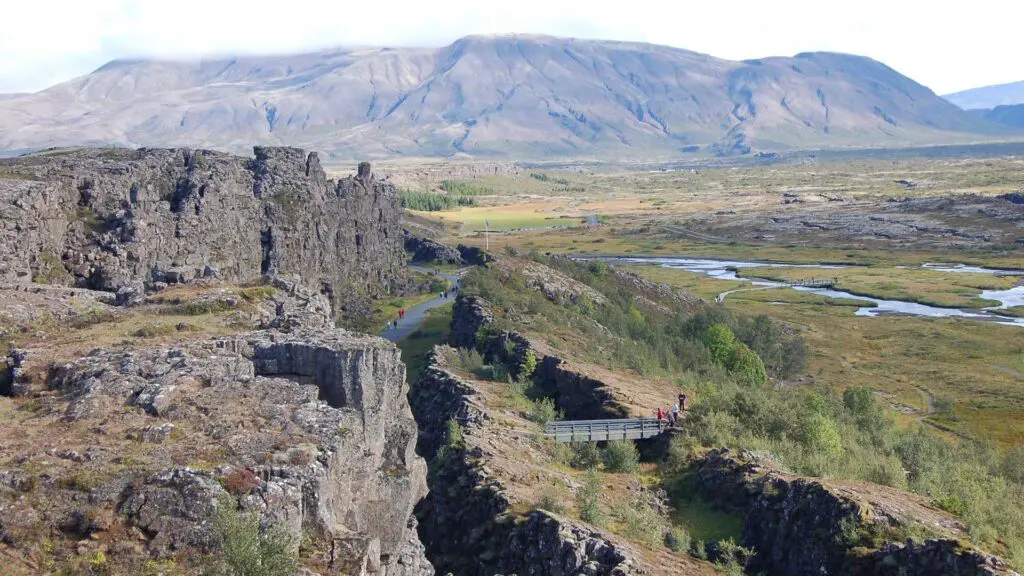
Þingvellir is more than just a historic site — it’s also a geological wonder. The park sits right on the boundary between the North American and Eurasian tectonic plates, and you can quite literally walk through the rift valley where the land is slowly pulling apart. It’s one of the only places on Earth where you can see this above sea level.
One of the main walks takes you through Almannagjá gorge, a dramatic canyon with towering cliffs on either side. Keep going and you’ll reach Öxarárfoss, a striking waterfall that spills over the edge of the rift into a rocky pool below. It’s not the biggest waterfall in Iceland, but it’s scenic and very photogenic, especially in winter when it partially freezes.
Several well-marked trails run through the park, and the landscape—a mix of lava fields, birch scrub, rivers, and lakes—is peaceful and starkly beautiful.
Geysir Geothermal Area

Located in the Haukadalur valley, this is the birthplace of the word “geyser”, named after the original Geysir, which once blasted water 70 metres into the air. While Geysir itself is now mostly dormant, the nearby Strokkur geyser is the show’s real star. It erupts roughly every 5 to 10 minutes, sending hot water up to 30 metres into the sky — often catching people by surprise if they’re not paying attention.
The whole area is bubbling with geothermal activity, including steaming vents, boiling mud pots, and bright mineral-rich pools. Wooden walkways make it easy to explore, and it’s a great spot for photography (or just standing around waiting for the next Strokkur blast).
Across the road, there’s also a large visitor centre with a café, gift shop, and bathrooms, making this a very accessible and popular stop.
Gullfoss Waterfall

Gullfoss (meaning “Golden Falls”) is one of Iceland’s most iconic and powerful waterfalls. It plunges in two dramatic stages — first a wide, curved fall and then a deep drop into a narrow canyon — creating a constant roar and clouds of mist that often produce rainbows on sunny days.
There are several viewing platforms at different levels, giving you a variety of angles to take in the scale of the falls. In the early 20th century, Gullfoss was nearly turned into a hydroelectric plant, but it was saved by Sigríður Tómasdóttir, often considered Iceland’s first environmental activist. There’s a small memorial to her near the falls.
This spot is often busy, but it’s large enough that it rarely feels overcrowded, and the sheer scale of the waterfall makes it worth every second.
Kerið Crater

Kerið is a volcanic crater lake around 3,000 years old, easily recognised by its deep red slopes and vibrant blue water. It’s about 55 metres deep and 170 metres wide, and it has a walking path all the way around the rim (which takes about 20 minutes). There’s also a trail down to the water’s edge, where you can appreciate the crater from below.
Unlike some other sites on the route, Kerið has a small entrance fee (around 450 ISK), but it’s worth it for the views. The striking contrast between the red volcanic rock, green moss, and blue lake makes for great photos, especially in golden hour light or with a dusting of snow.
It’s a relatively quick stop but a memorable one.
Secret Lagoon (Gamla Laugin), Flúðir
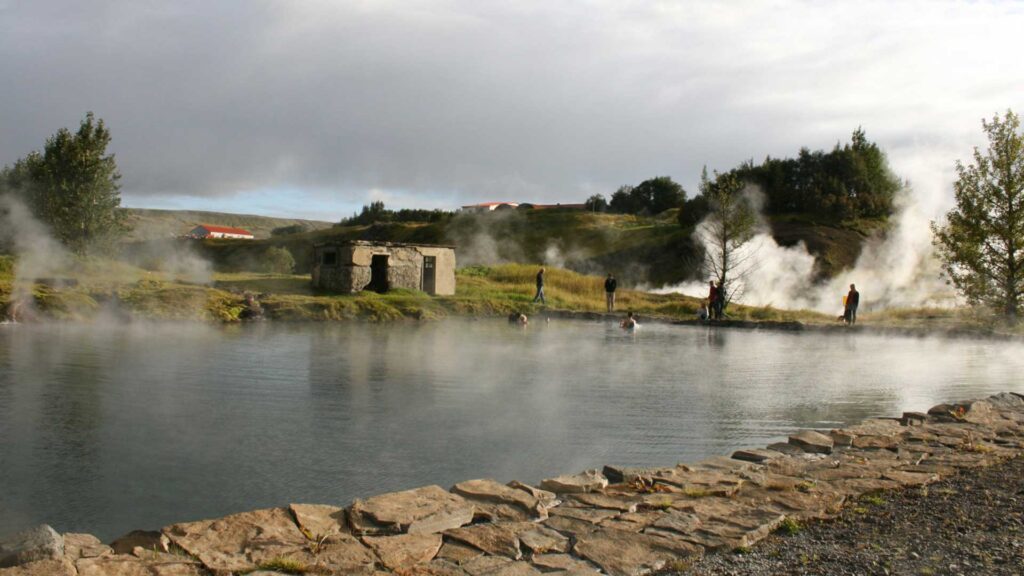
If you’re after a more relaxed and authentic soak, skip the Blue Lagoon and head to the Secret Lagoon instead. Located in the small town of Flúðir, Iceland’s oldest natural swimming pool opened in 1891. It still uses the same hot spring water, constantly flowing through the pool, keeping it clean and naturally warm year-round (around 38–40°C).
The setting is simple and rustic, with steam vents and small geysers bubbling nearby, giving the area a magical feel — especially in the colder months. There’s a small changing facility and a bar on site, and you can bring drinks into the pool, which is a bonus.
It’s far less commercial than the bigger spas and often quieter, especially if you go in the morning or evening.
Tours and Activities on the Golden Circle
There’s more than one way to experience the Golden Circle — whether you want a relaxing soak, a food-focused trip, or an underwater adventure. This Golden Circle travel guide includes a variety of tours and activities to help you make the most of your journey. Each one offers a unique way to see the sights, with options to suit different interests, travel styles, and pace.
Private Bespoke Golden Circle Tour

Take a Private Bespoke Golden Circle Tour in a luxury vehicle, tailored to your preferences.
The Golden Circle is one of Iceland’s most famous day routes, known for its powerful waterfalls, erupting geysers, historic sites, and striking geology — all within a short drive from Reykjavík.
Highlights include:
- Þingvellir National Park – A UNESCO World Heritage Site where the Alþingi, Iceland’s first parliament, was founded in 930 AD. It’s a unique mix of history and geology between two tectonic plates.
- Geysir Geothermal Area – Watch Strokkur geyser erupt every few minutes in a steaming landscape of bubbling hot springs and sulphur-scented vents.
- Gullfoss Waterfall – A thundering two-tiered waterfall dropping into a deep canyon. One of Iceland’s most iconic natural wonders.
Optional stops:
- Kerið Crater – A vivid volcanic crater with red slopes and a striking blue lake.
- Laugarvatn Fontana – Natural geothermal baths and steam rooms overlooking a quiet lake.
- Secret Lagoon – Iceland’s oldest swimming pool, fed by natural hot springs and surrounded by small geysers.
- Skálholt – Once the centre of Icelandic religious life, now home to a modern cathedral and archaeological exhibits.
- Friðheimar Tomato Farm – Enjoy lunch inside a working greenhouse, with a menu built entirely around fresh tomatoes.
Private Golden Circle Snorkeling Adventure

Set out on a Private Golden Circle Snorkeling Adventure in a luxury vehicle, tailored to your pace and interests.
This tour combines Iceland’s most famous natural and historical sights with an unforgettable underwater experience — snorkelling between two continents in the crystal-clear waters of Silfra Fissure.
Highlights include:
- Þingvellir National Park – A UNESCO World Heritage Site where the North American and Eurasian tectonic plates meet. Also the birthplace of Iceland’s parliament, founded in 930 AD.
- Geysir Geothermal Area – Home to steaming hot springs and Strokkur, the geyser that erupts every few minutes in a dramatic burst of water and steam.
- Gullfoss Waterfall – One of Iceland’s most impressive waterfalls, plunging in two tiers into a rugged canyon.
- Kerið Crater Lake – A striking volcanic crater filled with a vivid blue lake and surrounded by red volcanic rock.
- Snorkelling in Silfra – Float between continents in the clear, glacial waters of Silfra fissure. Visibility can reach over 100 metres, offering an otherworldly view of submerged lava formations and pure Icelandic spring water.
Optional stops:
- Laugarvatn Fontana – Relax in geothermal pools and natural steam rooms by Lake Laugarvatn.
- Secret Lagoon – Soak in Iceland’s oldest swimming pool, surrounded by steam vents and bubbling hot springs.
- Friðheimar Tomato Farm – Enjoy a tomato-themed lunch inside a warm greenhouse, surrounded by rows of thriving tomato plants.
Private Golden Circle Serenity Tour

Enjoy a Golden Circle Serenity Tour in a luxury vehicle designed for those who want to explore Iceland’s natural beauty and unwind in peaceful hot springs.
The Golden Circle is one of Iceland’s most iconic routes, featuring dramatic landscapes, geothermal activity, and centuries of history — all within easy reach of the capital.
Highlights include:
- Þingvellir National Park – A UNESCO World Heritage Site where Iceland’s parliament was founded in 930 AD. Set in a rift valley between two tectonic plates, the park is home to lava fields, the Öxarárfoss waterfall, and the crystal-clear Silfra fissure.
- Geysir Geothermal Area – A steaming geothermal field where Strokkur geyser erupts every few minutes, sending hot water high into the air. Explore bubbling pools and colourful mineral deposits all around.
- Gullfoss Waterfall – One of the most impressive waterfalls in Iceland. It drops in two dramatic stages into a rugged canyon, often framed by mist and rainbows.
- Hvammsvík Hot Springs – End the day soaking in a series of natural geothermal pools by the sea, surrounded by mountains and peaceful fjord views. With eight pools of varying temperatures and a modern spa-like setting, it’s the perfect way to relax after a day of exploring.
Optional stops:
- Kerið Crater – A red volcanic crater with a striking blue lake, easily explored via a short walk around the rim.
- Laugarvatn Fontana – Geothermal steam baths and warm pools located beside a calm lakeshore.
- Secret Lagoon – Iceland’s oldest pool, naturally heated and surrounded by small geysers and quiet countryside.
- Friðheimar Tomato Farm – Enjoy a unique lunch experience inside a greenhouse, where everything on the menu revolves around locally grown tomatoes.
Private Gourmet Golden Circle Tour

Embark on a Private Gourmet Golden Circle Tour in a luxury vehicle, where Iceland’s breathtaking sights are paired with delicious local flavours for a full-day experience unlike any other.
This tailored tour takes you through the Golden Circle’s iconic landscapes — waterfalls, geysers, and rift valleys — with hand-picked culinary stops woven into the journey. Perfect for food lovers and curious travellers who want to taste Iceland while exploring it.
Highlights include:
- Hveragerði Geothermal Park – Explore this geothermal town’s steaming vents and bubbling springs. Taste traditional rye bread baked in the hot ground and even try boiling an egg in a geyser — a fun, hands-on intro to Iceland’s volcanic energy.
- Skyrland – A one-of-a-kind museum dedicated to skyr, Iceland’s signature dairy product. Learn its 1,000-year history and sample different flavours in a modern setting.
- Made in Iceland – A quick stop to browse and sample locally made snacks, sweets, and artisan goods. A bite-sized taste of Icelandic culture.
- Friðheimar Tomato Greenhouse – Enjoy a standout lunch inside a working greenhouse, where everything on the menu features fresh, Iceland-grown tomatoes. A warm and unique setting with a focus on sustainability.
- Gullfoss Waterfall – A powerful, two-tiered waterfall crashing into a canyon below. One of the most photographed sites in Iceland and an unforgettable stop on the Golden Circle.
- Geysir Geothermal Area – See Strokkur geyser erupt every few minutes in a landscape alive with steam and boiling mud pools. The on-site restaurant also offers local dishes — including Icelandic lamb.
- Efstidalur Farm – Visit this working dairy farm for handmade ice cream, skyr, and cheese. Meet the cows, enjoy the peaceful rural setting, and get a taste of farm life.
- Þingvellir National Park – A UNESCO World Heritage Site with deep historical and geological significance. Walk between tectonic plates, visit the site of the ancient Alþingi (parliament), and admire waterfalls and lake views along the way.
Best Places to Eat and Drink on The Golden Circle
No road trip is complete without good food, and the Golden Circle has some excellent stops along the way. From cosy farm cafés to greenhouse restaurants and homemade ice cream, there’s plenty to enjoy between sightseeing stops. This Golden Circle travel guide highlights some of the best places to eat and drink along the route — perfect for fuelling up or winding down.
Friðheimar (Reykholt)

Imagine dining amidst rows of vibrant tomato plants. At Friðheimar, this is the reality. This family-run greenhouse restaurant specializes in cultivating tomatoes year-round thanks to geothermal energy. The menu is a tribute to the tomato, featuring dishes like their renowned tomato soup paired with freshly baked bread. The homemade tomato ice cream offers a sweet twist on the fruit for dessert. The ambience, combined with the freshness of the produce, makes for a memorable dining experience.
Efstidalur II (near Laugarvatn)

Efstidalur II seamlessly blends agriculture with gastronomy. This family-owned farm offers a restaurant where guests can savour farm-to-table dishes, with beef and dairy products sourced directly from their cattle. The menu features items like the Skyr Burger, topped with a homemade skyr patty and skyr sauce, emphasizing their dairy prowess. For dessert, their homemade ice cream, enjoyed while watching the cows in the stable below, is a delightful treat. The panoramic views of the surrounding valley further enhance the dining experience.
Lindin Bistro Café (Laugarvatn)
Nestled by the serene Laugarvatn Lake, Lindin Bistro Café offers a cosy atmosphere complemented by a diverse menu. Known for its emphasis on local ingredients, the restaurant serves dishes ranging from fresh fish to game meats. The warm interior, combined with lake views, provides a relaxing setting after a day of exploration.
Mika Restaurant (Reykholt)
Mika Restaurant is renowned for its fusion of flavours and dedication to quality. While its handmade chocolates are a highlight, the menu also boasts a variety of dishes, with its pizzas receiving particular acclaim. The combination of a warm atmosphere and culinary craftsmanship makes it a must-visit spot in Reykholt.
Farmers Bistro (Flúðir)
Situated on Iceland’s sole mushroom farm, Farmers Bistro offers a unique dining experience centred around locally cultivated produce. The menu highlights mushroom dishes and other local ingredients, catering to vegan and non-vegan preferences. They offer a buffet-style service during the summer, allowing guests to sample various creations. The bistro also provides insights into mushroom farming in Iceland, making it both an educational and gastronomic experience.
Folktales and Legends of the Golden Circle
Torfi’s Collapse at Alþingi

Once, during the national assembly at Alþingi, a man named Torfi was walking toward the Lögrétta (law council) to deliver a legal speech. The weather was clear and calm. Then, all of a sudden, people noticed a small black shape rising in the sky to the north, above Skjaldbreiður mountain.
As it came closer, it seemed to take the form of a bird, flying straight toward Þingvellir. When it reached the assembly grounds, it dove down directly onto Torfi.
The moment it happened, Torfi let out a terrifying scream and became violently agitated. His strength surged to the point that several men were needed to restrain him — and even then, it took some effort to get him under control and tied down.
His expression was so wild and intense, and his screaming so loud and unnatural that people were struck with fear. Many believed something unnatural or evil was at work.
The Bishop Comes to Help
Friends of Torfi and a few kind-hearted men begged Bishop Stefán to intervene and help. The bishop was hesitant — he didn’t see Torfi as particularly deserving of his aid — but eventually agreed out of compassion and duty.
With a group of clergymen, the bishop approached where Torfi lay. He draped his cloak sleeve over Torfi’s head, fell to his knees in prayer, and the others followed. Through prayer and hymn, the bishop and his priests gradually calmed Torfi’s torment, and his condition slowly improved.
After that incident, Torfi and the bishop developed a closer bond, though there was never full peace between them.
Still, things ended bitterly. When Torfi died shortly after the year 1500, his wish had been to be buried in Skálholt, having chosen his gravesite during his lifetime. But Bishop Stefán found him barely worthy of a Christian burial, and the church service for him was reluctantly granted and costly—especially for Torfi’s wife, who had to plead for his burial to be carried out.
Þórgunna’s Burial at Skálholt

In the early 11th century, a woman from the Hebrides named Þórgunna came to Iceland. She was known for being strong-willed and serious; many believed she was skilled in magic.
Þórgunna took up residence at Fróðá, near the base of Snæfellsjökull. That same autumn, not long after arriving, she fell ill with what she believed would be her final sickness.
As her condition worsened, she asked the farmer she was staying with to arrange for her body to be taken to Skálholt after her death. She said the site would one day become a place of honour and worship and that priests there could perform proper holy rites over her. The farmer honoured her wish and gathered men to carry her south to Skálholt.
They travelled overland, following the usual routes through the country. Nothing of note was recorded about the journey — until they reached Borgarfjörður. There, they stayed the night, and according to Eyrbyggja Saga, Þórgunna rose from the dead.
Despite this chilling event, the body-bearers continued their journey the next day and eventually brought her remains to Skálholt, where she was buried.
But as the grave was being prepared, the gravediggers discovered an old coffin lying on one side of the burial site. They ignored it and went on with their task.
Then, just as Þórgunna’s coffin was being lowered into the ground, the men heard her speak from inside:
“Cold are the feet
of the ugly one.”
Immediately after, another voice was heard — this time from within the old coffin:
“Few care for
Þórgunna.”
No one knew what it meant or who was buried in the older grave. The mystery remained unsolved.




